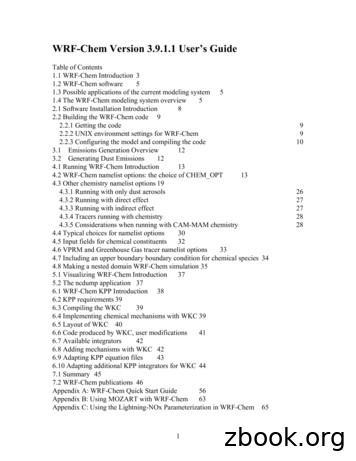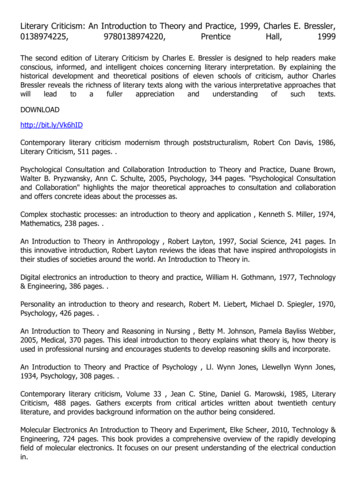CHEM 355 EXPERIMENT 2 Conductimetric Titration
CHEM 355EXPERIMENT 2Conductimetric Titration-1Conductance, G is the reciprocal of its resistance and has unit Ω . The SI unit for conductance is-1Siemens and 1 Siemens 1 Ohm𝐺 1/𝑅(1)The conductivity of a solution depends on the number of ions, therefore, it is introduced as molarconductivity. Conductivity of ions depends on several factors including concentration, size, charge of theion and temperature. In general, conductivity varies with concentration but conductivity sometimes cannotbe correlated with concentration since some deviations can be observed due to the interactions.Temperature also effect the conductivity but the dependence of conductivity on temperature varies fordifferent solutions. Another factor affecting conductivity is its size, as size of the ion decreases itsconductivity increases.Conductivity can also be used for conductimetric titration that involves measurement of the conductanceof the sample solution after successive additions of reagent if the concentrations of various ions insolution are chancing. The conductance of the sample is measured after successive addition of thereagent and the end point is determined from a plot of the conductance or the specific conductance as afunction of the volume of added titrant. These titration curves take variety of shapes depending on thechemical system under investigation. In general, however, they are characterized by straight-line portionswith dissimilar slopes on either side of the equivalence point. The intersections of the two straight-lineportions give the end point. Conductimetric titration can be applied to strong acid - strong base, weak acid- strong base, precipitation and complex formation titrations.Strong acid- strong base titration: HCl is strong electrolyte and completely dissociates in wateraccording to the formula below:HCl(aq) NaOH(aq) -NaCl(aq) H2O(aq) -During the titration, H is reacted with OH and Na , Cl and H2O are formed. It is obvious that as thetitration proceeds towards the end point, the highly conducting hydrogen ions are being replaced bysodium ions of much lower conductance. Thus, conductivity of solution decreases up to end point. Afterthe end point due to the addition of excess NaOH conductance increases again but slopes of the curves are different due to the conductivity differences between H and OH as shown in the Figure 1.conductivityor specificconductancemL of alkaline addedFigure 1. Strong acid- strong base conductimetric titration curve
Weak acid- strong base titration: Weak acid does not completely ionize in solution therefore at thebeginning of the titration its conductivity is low.HAc (aq) NaOH(aq)- Na (aq) Ac-(aq) H2O(aq)-OH reacts with H and Na , Ac form and conductivity stats to increase. After the end point, excess OHions result increase in conductance because of the relatively greater mobility of OH .-conductivityor specificconductancemL of alkaline addedFigure 2. Weak acid- strong base conductimetric titration curveWeak acid- strong acid and strong base titration: When strong acid and weak acid were titrated, thegraph shown below is observed. The first end point is belonging to strong acid whereas second onebelongs to weak acid.conductivityor specificconductancewsmL of alkaline addedFigure 3. Weak acid- strong acid- strong base conductimetric titration curvePrecipitation titration: When the precipitation titration is done by using conductimeric titration the graphshown below is observed. In the titration of magnesium sulphate with barium hydroxide, barium sufate2 2precipitate. At the begining of the titration, Mg and SO4 ions are present in the solution. At the endpoint all ions were replaced with precipitate conductance decreased to zero. After end point due to theaddition of excess Ba(OH)2 conductivity increases again.
conductivityor specificconductancemL of alkaline addedFigure 4. Precipitation titration conductimetric titration curvePurpose: To determine end point of strong acid- strong base, weak acid- strong base and strong acidweak acid- strong base titrationApparatus and ChemicalsApparatus: Conical flask, burette, conductometer.Chemicals: HCl, NaOH, CH3COOHProcedureI.Strong acid- strond base titration1.2.3.4.5.6.7.Put 20 mL 0.2 M HCl in conical flaskFill the burette with 0.05 M NaOHPut the probe of the conductometer into the flaskStart the titration of HCl with NaOHRead the conductance in each mLAt about end poit add 0.5 mL portions after each conductance readingRead the conductance until 4-5 mL after end pointII.Weak acid- strong base titrationIn this part of the experiment you will do weak acid strong base titration. 0.05M, 20 mL CH3COOH istitrated with 0.05M NaOH. perform same procedure mentioned above.III.Mixture of weak acid, strong acid and strong base titration0.02M, 10 mL HCl and 0.02M, 10 ml acetic acid mixture is titrated with 0.05 M NaOH. Perform sameprocedure mentioned above.WASTE CONTAINER: AQUEOUS
Treatment of Data1. Plot conductance versus volume of titrant added graphs for each part.2. Find theoretical and experimental end points.Questions1. Compare the theoretical and experimental end points, discuss the results and possible source oferrors.2. Discuss the increasing and decreasing lines on the graphs by writing all of the ions present ineach region on the graphs.3. Write the advantages of conductimetric titrations. 4. Why the conductivity of H and OH is higher?
DATA SHEETExperiment 2 Conductimetric TitrationGroup Number:Date:Assistant name and signature:Table 1. Strong acid- strong base titrationVolume ofadded NaOH (mL)conductanceVolume ofadded NaOH (mL)conductanceTable 2. Weak acid strong base titrationVolume ofadded NaOH (mL)Conductance(S)Volume of added NaOH(mL)Conductance(S)
Table 3. Weak acid- strong acid- weak base titrationVolume ofadded NaOH(mL)Conductance(S)Volume ofadded NaOH(mL)Conductance(S)
II. Weak acid- strong base titration In this part of the experiment you will do weak acid strong base titration. 0.05M, 20 mL CH 3 COOH is titrated with 0.05M NaOH. perform same procedure mentioned above. III. Mixture of weak acid, strong acid and strong base titration 0.02M, 10 mL HCl and 0.02M, 10 ml acetic acid mixture is titrated with 0.05 .
GV Series 4 Jackets Note: All Jacket Panels come with appropriate labels Item Description Boiler Size Part Number 3 381-355-762 4 381-355-769 5 381-355-766 6 381-355-770 All 381-355-764 2 Pocket for front door All 422-200-139 3 381-355-763 4 381-355-765 5 381-355-767 6 381-355-768 All 422-200-230 3
355-1 x1763355-1 motor fan cover 355-8 x1763355-8 contact plate 16mm 355-2 x1763355-2 motor fan 355-9 xp6205zz ball bearing 6205zz 355-3 x1763355-3 capacitor cover 355-10 xp6203zz ball bearing 6203zz 355-4v2 x1763355-4v2 s capacitor 200m 250v v2.08.07 407v2 x1763407v2 machine id label csa v2.07.12 355-5 x1763355-5 capacitor cover read this first
CHEM 350B Topics in Chemistry 7.5 454.95 CHEM 351 Chemicals Big and Small: Nano- 15 909.90 CHEM 352 Advanced Concepts in Chemistry 15 909.90 CHEM 352A Advanced Concepts in Chemistry 7.5 454.95 CHEM 352B Advanced Concepts in Chemistry 7.5 454.95 CHEM 360 Contemporary Green Chemistry 15 909.90 CHEM 380 Materials Chemistry 15 909.90
CHEM 31X. Chemical Principles 4 CHEM 33. Structure and Reactivity 4 CHEM 35. Organic Monofunctional Compounds 4 CHEM 36. Organic Chemistry Laboratory I 3 MATH 41, 42, 51. Calculus, Linear Equations 5 5 5 SECOND YEAR CHEM 130. Organic Chemistry Laboratory II 4 CHEM 131. Organic Polyfunctional Compounds y3 CHEM 134.
Low Mid High Launch Spin Low Mid High Launch Spin KBS Hi-Rev 2.0 Wedge Flex R S X Tip.355" .355" .355" Weight (g) 115 125 135 Torque N/A N/A N/A Launch Mid Mid Mid Program Stock Stock Stock KBS TOUR 105 Flex R S X Tip.355" .355" .355" Weight (g) 105 110 115 Torque 2.5 2.5 2.5 Launch Mid-High Mid-High Mid-High Spin Mid-High M
CHEM 110 Chemistry of the Living World 15 4,736.85 CHEM 120 Chemistry of Material World 15 4,736.85 CHEM 150 Concepts in Chemistry 15 4,736.85 CHEM 200 Special Topic 15 4,736.85 CHEM 251 Structure and Spectroscopy 15 4,736.85 CHEM 252 Properties and Analysis of Mat 15 4,736.85
WRF-Chem Version 3.9.1.1 User’s Guide Table of Contents 1.1 WRF-Chem Introduction3 1.2 WRF-Chem software 5 1.3 Possible applications of the current modeling system 5 1.4 The WRF-Chem modeling system overview 5 2.1 Software Installation Introduction 8 2.2 Building the WRF-Chem code 9 2.2.1 Getting the code 9
273 pages Literary Criticism: An Introduction to Theory and Practice 0138974225, 9780138974220 F and S Index International 2005 Subscription , Gale Group, 2005, Business & Economics, . F& S Indexes offer you a handy compilation of company, product and industry information from financial publications, business-oriented newspapers, trade magazines and special The analysis of time series data has .


















